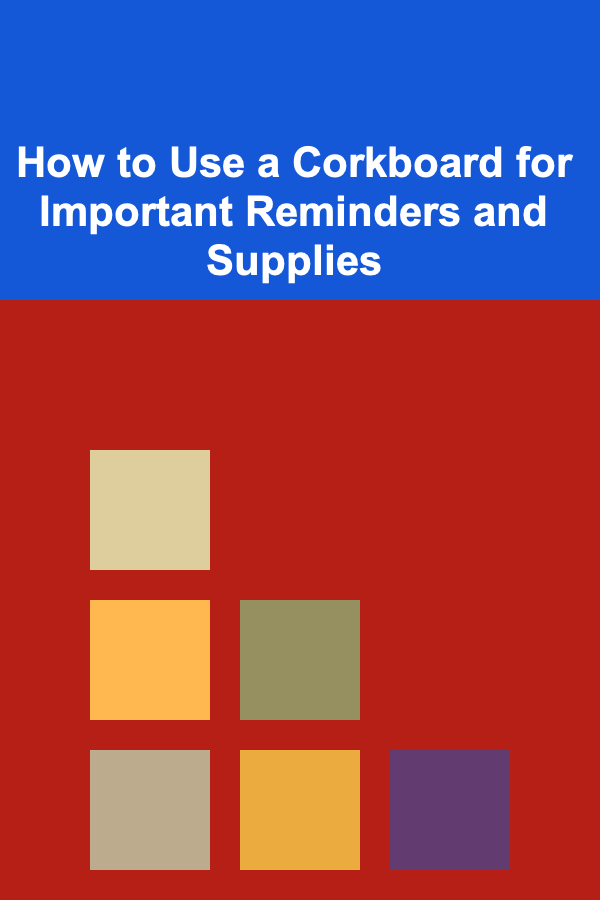
How to Use a Corkboard for Important Reminders and Supplies
ebook include PDF & Audio bundle (Micro Guide)
$12.99$8.99
Limited Time Offer! Order within the next:

Corkboards have been a staple organizational tool in homes, offices, and classrooms for decades. They serve as versatile surfaces where you can pin notes, reminders, photos, and important documents, providing a visual method for maintaining organization and enhancing productivity. This article will explore the various ways to utilize a corkboard effectively for managing important reminders and supplies, ensuring that you maximize its potential.
Introduction
Amidst the digital age, it may seem counterintuitive to use physical tools like corkboards for organization. However, the tactile nature of corkboards provides a sensory experience that screens cannot replicate. The act of pinning a reminder or a photo to a board can reinforce memory and commitment to tasks. This article provides a comprehensive guide on how to utilize a corkboard effectively for your reminders and supplies, ensuring you stay organized and productive.
The Benefits of Using a Corkboard
Corkboards offer a multitude of advantages that make them an excellent choice for organization:
- Visual Reminder: Unlike digital tools that can be forgotten behind numerous tabs and applications, a corkboard serves as a constant visual reminder, catching your attention throughout the day.
- Customizable Space: Corkboards allow for personalization. You can arrange items in a way that makes sense to you, using colors, themes, or categories.
- Tactile Interaction: The physical act of pinning or unpinning items can enhance engagement with your reminders and tasks.
- Easy Accessibility: Important information is readily available without needing to search through files or folders.
- Encourages Creativity: A corkboard can also function as a creative outlet, allowing you to display artwork, inspiration boards, or vision statements.
Choosing the Right Corkboard
1. Size Matters
Corkboards come in various sizes. Consider the space where you plan to place it and how much information you intend to display. A larger board may be suitable for communal areas, while a smaller one works well in personal spaces.
2. Frame Style
Corkboards are available in different frame styles. Choose one that complements your décor---whether minimalist, rustic, or modern---to create a cohesive look.
3. Material Quality
Look for corkboards made from high-quality materials to ensure durability. Some boards have a self-healing surface, which means they can withstand repeated pinning without showing wear.
4. Mounting Options
Decide whether you want a wall-mounted board or a freestanding one. Wall-mounted boards save space, while freestanding boards can be moved easily and positioned anywhere.
Setting Up Your Corkboard
Creating an efficient corkboard setup involves careful planning and execution. Follow these steps:
1. Location Matters
Choose a spot where your corkboard will be most effective. Ideal locations include:
- Home Office: Within sight while working.
- Kitchen: For family reminders and meal planning.
- Entryway: To catch your attention as you leave or enter your home.
- Classroom: For teachers, a corkboard can serve to communicate important information to students.
2. Gathering Supplies
Before setting up your corkboard, gather the necessary supplies:
- Pins: Various types, such as push pins, decorative pins, or thumbtacks.
- Reminders/Notes: Sticky notes, index cards, or printed documents.
- Decorative Items: Washi tape, markers, and other embellishments to personalize your board.
Organizational Strategies for Your Corkboard
Once your corkboard is set up, implementing effective organizational strategies is essential. Here are some methods to consider:
1. Categorizing Information
Divide your board into sections based on categories. This helps to declutter and makes it easier to locate specific information. Common categories might include:
- To-Do Lists: Pin your immediate tasks or goals here.
- Important Dates: Highlight upcoming appointments, birthdays, or deadlines.
- Motivational Quotes: Include inspiring quotes that encourage you to stay focused.
- Visual Inspiration: Add images or clippings that inspire you creatively or personally.
2. Using Color Coding
Color coding can enhance organization and improve visibility. Assign specific colors to different categories:
- Red: Urgent tasks
- Blue: General reminders
- Green: Goals or achievements
- Yellow: Inspirational quotes
Using colored paper or sticky notes can also help track progress on varying tasks.
3. Incorporating Visual Elements
Visual elements can make your corkboard more engaging and easy to interpret:
- Photos: Pictures of loved ones or places can serve as motivation.
- Charts and Graphs: If you're tracking progress (like workouts), consider pinning graphs or charts.
- Doodles or Artwork: Personal touches add character and warmth to your board.
Maintaining Your Corkboard
An organized corkboard requires regular upkeep. Here's how to maintain it effectively:
1. Regular Review
Set aside time weekly or monthly to review your board. Remove outdated reminders or completed tasks, and adjust any categories as needed.
2. Seasonal Updates
As seasons change, so do priorities and reminders. Refresh your corkboard every season to reflect current goals and tasks.
3. Keep It Simple
Avoid overcrowding your corkboard. Limit the number of items displayed to ensure clarity and focus.
Creative Uses for Your Corkboard
Beyond standard reminders, there are numerous creative applications for corkboards:
1. Vision Board
Transform your corkboard into a vision board showcasing your dreams and aspirations. Pin images, quotes, and goals to visualize what you wish to achieve.
2. Project Tracker
For ongoing projects, use your corkboard to track milestones and deadlines. Pin relevant documents, timelines, and notes that keep you on target.
3. Recipe Board
In the kitchen, dedicate a corkboard to pinging favorite recipes, grocery lists, or meal plans. This keeps your culinary inspirations visible and accessible.
4. Family Calendar
Use your corkboard to create a family calendar by pinning important dates for each family member. This ensures everyone stays informed about events and activities.
5. Memory Board
Collect memories by pinning tickets, postcards, or photographs that represent experiences. This can serve as a nostalgic display that reminds you of cherished moments.
Common Challenges and Solutions
While organizing your corkboard presents many benefits, challenges may arise. Here are common issues and their solutions:
1. Overcrowding
Challenge: Too many items can create clutter and confusion.
Solution: Be selective about what you pin. Regularly assess and remove outdated or irrelevant items to maintain clarity.
2. Difficulty Accessing Pins
Challenge: If items are densely packed, finding specific pins can be difficult.
Solution: Prioritize layout by placing frequently accessed items towards the top or center of the corkboard.
3. Damage to Cork Board
Challenge: Repeated pinning can lead to holes or damage.
Solution: Use push pins designed to be less damaging, or consider rotating the placement of pinned items.
4. Loss of Interest
Challenge: Over time, a corkboard can lose its appeal.
Solution: Refresh the look with new colors, designs, or themes. Change out visuals and quotes periodically to inspire continued engagement.
Conclusion
A corkboard is a functional and creative tool for organizing important reminders and supplies. By choosing the right size, location, and organizational strategies, you can transform your corkboard into a dynamic visual aid that enhances your productivity and creativity.
Regular maintenance, categorization, and visual elements will keep your corkboard engaging and effective. Whether used for personal reminders, family calendars, or creative projects, a well-organized corkboard can serve as a valuable asset in your daily life. Start utilizing your corkboard today, and experience the myriad benefits it brings to your organization and mindfulness!

Build AI Tools with Deep Learning to Create Long-Term Income
Read More
How To Brew Turkish Coffee for a Rich Experience
Read More
How to Budget for Home Cleaning and Organization Services
Read More
How to Care for Your Home's Air Conditioning System
Read More
How to Interpret Mythological Journeys and Quests
Read More
The Ultimate Guide to Saving Money on Prescription Medications: What You Need to Know
Read MoreOther Products

Build AI Tools with Deep Learning to Create Long-Term Income
Read More
How To Brew Turkish Coffee for a Rich Experience
Read More
How to Budget for Home Cleaning and Organization Services
Read More
How to Care for Your Home's Air Conditioning System
Read More
How to Interpret Mythological Journeys and Quests
Read More